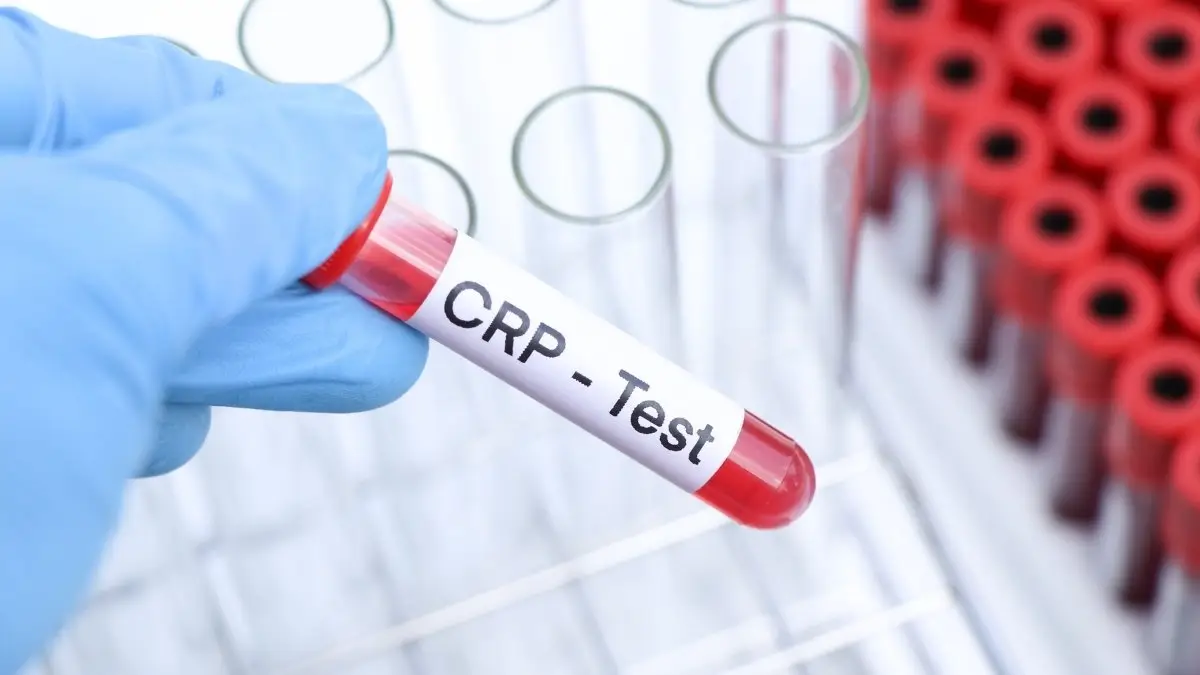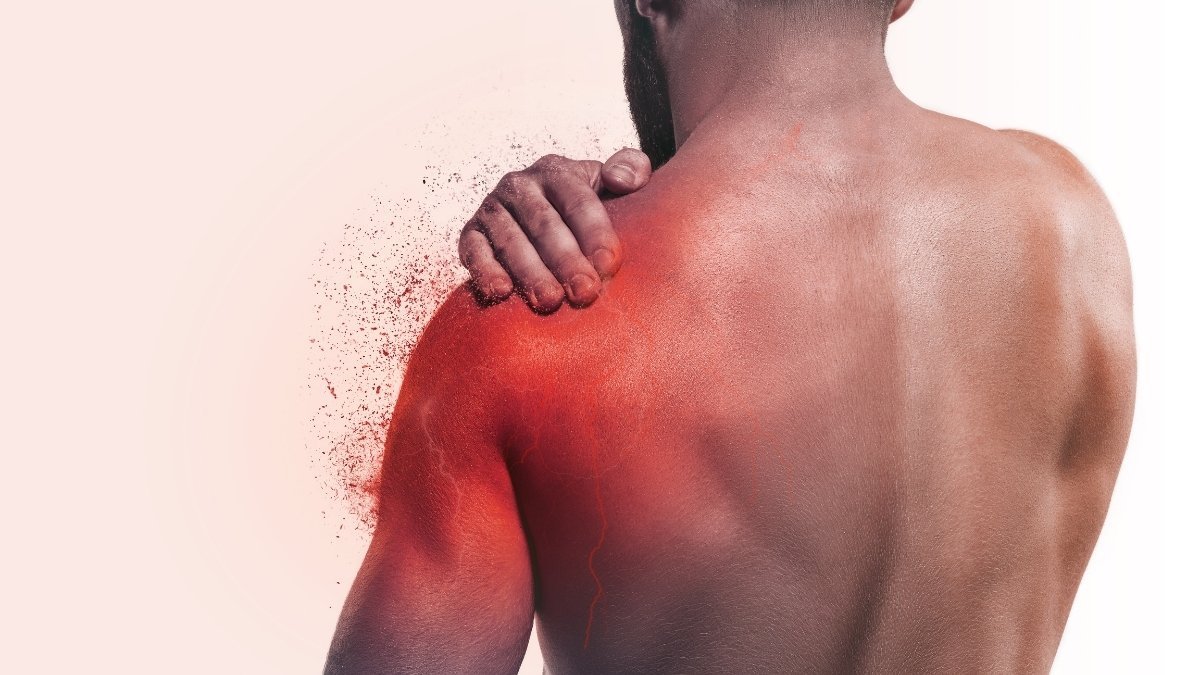You believe your annual physical has you covered. Your cholesterol numbers look good, you try to eat right, and you stay active. So why do nearly half of all heart attacks strike people with normal cholesterol?
The answer is a silent fire burning inside your arteries: chronic inflammation. Your doctor probably isn’t checking for it, but this single factor can be a more accurate predictor of your future heart risk than anything on a standard lipid panel.
This guide breaks down the simple blood test that spots this hidden danger—the hs-CRP test. You’ll get a clear, actionable plan for 2025 to put out the fire and take back control of your heart health.
What Is Chronic Inflammation and Why Does It Matter?
The Silent Threat: Unmasking Chronic Inflammation
Did you know? Nearly 50% of heart attacks and strokes occur in individuals with *normal cholesterol levels*. This startling statistic highlights a deeper underlying issue than just “clogged pipes.”
Chronic vs. Acute Inflammation: While acute inflammation is your body’s healthy rapid response to injury (like a firefighter putting out a blaze), chronic inflammation is like a “smoldering fire” that never fully extinguishes, causing long-term damage.
Research indicates that chronic inflammation is a key driver in the progression of atherosclerosis, impacting every stage from initial artery damage to the final, dangerous plaque rupture. It’s not just about plaque quantity, but its *stability*.
The high-sensitivity C-reactive protein (hs-CRP) test is your “smoke detector” for hidden inflammation. Unlike a regular CRP test, hs-CRP can detect the subtle, low-grade inflammation linked to heart disease risk, even in otherwise healthy individuals.
A 2010 review of studies involving over 160,000 people revealed that every standard increase in hs-CRP levels raised the risk of heart disease by 1.37 times, underscoring its predictive power independent of cholesterol.
Prevalence: Data from NHANES shows that 52% of U.S. adults have elevated hs-CRP levels (≥2 mg/L), indicating that this hidden risk factor is remarkably common and often overlooked.
For years, we’ve been told that heart disease is all about cholesterol. The story was that our arteries are like pipes that get clogged with fat.
This is partly true, but it doesn’t tell the whole story. Here’s the problem: nearly half of all heart attacks and strokes in the U.S. happen to people with normal cholesterol levels.
This fact points to something else going on. It’s a slow, simmering fire inside the body called chronic, low-grade inflammation. Learning about this process is the first step to better protecting your heart.
Good vs. Bad Inflammation: What’s the Difference?
Inflammation itself is not bad. When you get a cut, the skin around it gets red and puffy. That’s your body’s defense system rushing to fight germs and fix the damage. This is good inflammation. It’s like a firefighter that puts out a fire and then leaves.
Chronic, low-grade inflammation is different. It’s a condition where your body’s defense system stays turned on at a low level all the time. It’s like a fire that smolders for months or years and never goes out.
Instead of healing, this constant state of alert damages healthy parts of your body. This quiet hum of inflammation is a key cause of many modern diseases, like type 2 diabetes and heart disease.
How Inflammation Damages Your Arteries
We now know that inflammation is a key player in atherosclerosis—the hardening and narrowing of your arteries. It’s involved in every step, from the first bit of damage to the final plaque rupture that causes a heart attack or stroke.
It starts when the inner lining of an artery gets hurt by things like high blood pressure or high blood sugar. This triggers an inflammatory response. Your immune cells rush to the scene.
They gobble up bad cholesterol particles and turn into “foam cells,” which start to form plaque in the artery wall. This keeps the inflammation going and makes the plaque bigger.
More importantly, inflammation makes plaque unstable. An inflamed plaque is soft and weak. It’s more likely to break open, spill its contents, and cause a blood clot. That clot can block blood flow to the heart (a heart attack) or the brain (a stroke).
A hard, stable plaque is often less dangerous than a smaller, inflamed one. So, the real danger is not just how much plaque you have, but how much inflammation is in it.
How to Measure This Hidden Inflammation
If inflammation is the fire, the high-sensitivity C-reactive protein (hs-CRP) test is the smoke detector. C-reactive protein (CRP) is a protein your liver makes when there is inflammation in your body.
For years, doctors have used a regular CRP test to find high levels of inflammation from infections or diseases like rheumatoid arthritis.
But that test isn’t sensitive enough to find the low-grade inflammation that causes heart disease. That’s why the high-sensitivity C-reactive protein (hs-CRP) test was created.
It can spot very small increases in CRP, giving a clear picture of your risk. It’s a simple, cheap blood test that shows what’s happening inside your arteries.
Is Inflammation a Bigger Risk Than Cholesterol?
A lot of research, led by cardiologist Dr. Paul M. Ridker from Harvard Medical School, shows that hs-CRP is a strong and independent predictor of future heart problems.
Many large studies have found that high hs-CRP levels predict the risk of heart attack and stroke, even when all other risk factors, including cholesterol, are normal.
A 2010 review of studies with over 160,000 people found that every standard increase in hs-CRP raised the risk of heart disease by 1.37 times.
This has changed how we think about heart risk. As Dr. Ridker says, “atherosclerosis is as much an inflammatory disease as it is a disorder of lipids”. The biggest risk is for people who have both high LDL cholesterol and high hs-CRP.
They have the material to build plaque and the fire to make it dangerous. This explains why many people with normal cholesterol still have heart attacks—their risk comes from inflammation.
A 2025 statement from the American College of Cardiology (ACC) confirms this, saying, “In patients with known CVD, hs-CRP level is at least as predictive of future events as LDL cholesterol levels”. This shows why we need to look beyond just cholesterol.
Data from the National Health and Nutrition Examination Survey (NHANES) found that 52% of U.S. adults have high hs-CRP levels ($≥2$ mg/L), meaning this hidden risk is very common.
The hs-CRP Test: How to Get It, What It Costs, and How to Read Your Results

Getting your hs-CRP level checked is a simple, cheap blood test that can tell you a lot about your long-term health. The first step to fighting chronic inflammation is to know how the test works, what the results mean, and how to ask for it.
There is a big “care gap” today: more than half of adults at risk have high hs-CRP, but less than 1% are getting tested. This means you need to be your own health advocate.
Understanding the Numbers: What Your Level Means
Your hs-CRP result is measured in milligrams per liter (mg/L). The American Heart Association (AHA) and the U.S. Centers for Disease Control and Prevention (CDC) have set up clear risk levels.
- Low Risk: Less than $1.0$ mg/L.
- Average Risk: Between $1.0$ and $3.0$ mg/L.
- High Risk: Greater than $3.0$ mg/L.
It’s important to know that a level above $10.0$ mg/L usually means you have a temporary issue, like an infection or injury. A result this high is not a sign of your long-term heart risk. If you get a high result, the test should be done again 2 to 3 weeks after you feel better.
Who Should Get Tested in 2025?
In the past, the hs-CRP test was mainly for people at “intermediate risk” of a heart attack (a 5% to 20% chance in the next 10 years).
A high hs-CRP level in these cases would help doctors decide on stronger lifestyle changes or medicine, like statins.
But things are changing quickly. A major 2025 statement from the American College of Cardiology (ACC) now recommends hs-CRP screening for everyone being checked for heart disease risk.
This makes the hs-CRP test a basic part of a modern heart check-up, just like a cholesterol test. When you ask for this test, you are asking for the most up-to-date care.
How to Ask Your Doctor for the Test
With this information, you can ask for the test with confidence. Many doctors don’t order it for everyone yet, so being prepared helps. You can say something simple like:
Logistics and Cost
The hs-CRP test is a normal blood draw from a vein in your arm. There is very little risk.3You usually don’t need to fast unless you are getting other tests at the same time that require it, like a cholesterol panel.
Cost is not a big issue. The out-of-pocket price for the test is usually between $35 and $79 in 2025. You can get it through many direct-to-consumer lab services, which makes it easy to get even without a doctor’s order.
How to Get an Accurate Result
To get the most accurate result, you should avoid very hard exercise for 24 hours before the test. A long run or heavy weightlifting can cause a temporary spike in CRP. Also, make sure you are not sick when you take the test.
Because hs-CRP levels can change a little, doctors often look at the average of two tests taken a couple of weeks apart. This helps confirm that a high level is a real issue and not just a temporary blip.
| hs-CRP Level (mg/L) | Cardiovascular Risk Category | What It Means & What to Do Next |
| $<1.0$ | Low Risk | Great. This means you have very low inflammation. Keep up your healthy lifestyle. |
| $1.0 – 3.0$ | Average/Moderate Risk | This shows some low-grade inflammation. It’s a good time to make lifestyle changes to stop it from getting worse. Talk to your doctor. |
| $>3.0$ | High Risk | This means you have a lot of inflammation and a much higher heart risk. You should make serious lifestyle changes and talk to your doctor about medicines (like statins), no matter what your cholesterol is. |
| $>10.0$ | Acute Inflammation | This is likely from something other than heart risk, like an infection. It does not show your baseline risk. Get tested again in 2-3 weeks after you are fully recovered. |
4 Simple Ways to Lower Your hs-CRP

So you know what hs-CRP is and why it’s important. Now, what can you do about it? A high hs-CRP level is a warning sign. It’s a chance to make changes and improve your health.
The good news is that you can lower chronic inflammation with lifestyle changes. This 4-step plan is based on the latest science for lowering hs-CRP and heart risk.
These steps—Precision Nutrition, Strategic Exercise, Stress & Inflammation Control, and Evidence-Based Supplementation—work together to put out the inflammatory fire.
Pillar 1: Eat These Foods to Fight Inflammation

The food you eat can be your best medicine or your slowest poison. Your diet is the biggest factor you can control when it comes to chronic inflammation. The goal is to eat fewer foods that cause inflammation and more foods that fight it.
The Best Eating Plan: The Mediterranean Diet
The Mediterranean diet is the most studied and effective way of eating to reduce inflammation and improve heart health. It’s not a strict diet but a way of eating that focuses on whole foods.
The famous PREDIMED trial showed its benefits. People who followed a Mediterranean diet with extra-virgin olive oil or nuts had far fewer heart attacks and strokes than those on a standard low-fat diet.
A 2023 review of 15 trials confirmed that a Mediterranean diet with olive oil lowers CRP levels.
Specific Actions You Can Take
Here are some specific goals based on research that links certain foods to lower CRP.
Eat More Vegetables:
Aim for at least 2 servings of vegetables every day. A 2018 study found this was linked to lower CRP levels. Choose dark leafy greens like spinach and kale.
These are key parts of the Low Inflammatory Foods Everyday (LIFE) diet, which in one study, dropped average CRP levels from a high-risk $7.0$ mg/L to a healthy $1.75$ mg/L in six months.
Eat More Fruits:
Have at least 3 pieces of fruit a day. This was also linked to lower CRP in the same 2018 study. Focus on fruits like blueberries and strawberries, which are full of compounds that fight inflammation.
Choose Fatty Fish:
Eat at least 3 servings of fish or seafood a week. This helps lower CRP because of the anti-inflammatory omega-3 fats, EPA and DHA. The best choices are fatty fish like salmon, mackerel, and sardines.
Use Olive Oil:
Use extra-virgin olive oil (EVOO) for cooking and on salads. Aim for up to 4 tablespoons a day, as used in the PREDIMED trial. EVOO has a compound called oleocanthal, which works like ibuprofen to fight inflammation.
Foods to Avoid
What you don’t eat is just as important as what you do eat. These foods are known to cause inflammation.
Ultra-Processed Foods (UPFs): These are factory-made foods with lots of additives and unhealthy fats. A 2025 study found that people who ate the most UPFs had much higher hs-CRP levels.
Sugar and Refined Carbs: This includes sodas, candy, white bread, and white pasta. These foods cause blood sugar spikes that trigger inflammation.
Unhealthy Fats: Stay away from trans fats, which are often listed as “partially hydrogenated oils.” Also, limit processed meats like bacon and sausage, and cut back on vegetable oils like soybean and corn oil.
How to Exercise to Lower Inflammation

Regular exercise is one of the best ways to lower chronic inflammation. People who are more fit have hs-CRP levels that are 6-35% lower than people who don’t exercise.
Exercise helps by reducing body fat, especially the fat around your organs that produces inflammatory signals.
But it’s not just about exercising; it’s about exercising in the right way.
Aerobic Exercise: The Best Choice
The best evidence for lowering hs-CRP comes from aerobic exercise. Based on many studies, here is a good plan:
- How Often: 3 to 5 times a week.
- How Long: 30 to 60 minutes each time.
- How Hard: Moderate intensity. You should be able to talk but not sing.
- What to Do: Brisk walking, jogging, cycling, or swimming.
Being consistent is more important than doing one really hard workout. Regular activity like this helps your body stay in an anti-inflammatory state.
Strength Training: A Good Helper
Strength training is also helpful. It builds muscle, improves how your body uses insulin, and helps with fat loss.
But it may take six months or more of regular training to see a big drop in hs-CRP. The best plan is to do both aerobic and strength training. A 16-week study showed that this combination leads to big drops in hs-CRP.
A Note on Intensity
It’s important to know that the link between exercise intensity and inflammation isn’t a straight line.
No exercise is bad, and moderate exercise is good. But extremely hard exercise, like running a marathon, can cause a temporary spike in hs-CRP. Even a tough stress test can raise it a little.
This doesn’t mean hard exercise is bad. It just means two things. First, the goal for long-term health is to build a habit of moderate exercise.
Second, do not get your hs-CRP level checked in the 24-48 hours after a very hard workout. The result will be high for a short time and won’t show your true baseline.
The Power of Weight Loss
The benefits of exercise are much bigger when they lead to weight loss. A review of 83 trials found that while exercise alone can lower CRP, the drop is much greater when you also lose weight.
The numbers are very specific: for every 1 kilogram (2.2 pounds) you lose, your hs-CRP level drops by an average of 0.13 mg/L. If your hs-CRP is a high-risk 4.5 mg/L, losing just 20 pounds could lower it by 1.17 mg/L.
This could move you from high risk to average risk. This shows how important it is to combine exercise with a healthy diet.
Why Stress Makes Inflammation Worse (And How to Fix It)

The link between your mind and body is real. Chronic stress is a powerful and often ignored cause of physical inflammation. Learning how to manage stress is a key part of any plan to lower inflammation.
How Stress Causes Inflammation
Your body’s stress response involves two main systems: the fast “fight or flight” response and the slower HPA axis. When you feel stressed, these systems get activated. The HPA axis releases the hormone cortisol.
In a short-term stress situation, cortisol helps fight inflammation. But with chronic stress, something bad happens. Your body’s cells get so used to cortisol that they stop listening to its anti-inflammatory signal.
This lets other stress hormones cause inflammation without anything to stop them. The result is a constant state of low-grade inflammation that raises hs-CRP levels.
A Proven Tool: Mindfulness-Based Stress Reduction (MBSR)
Instead of just saying “reduce stress,” there is a specific method that works: Mindfulness-Based Stress Reduction (MBSR).
This is an 8-week program that teaches you to pay attention to the present moment without judging it. It’s not just about relaxing; it’s a way to train your mind to respond to stress differently.
A study from the University of Wisconsin tested it directly. Researchers compared a group doing the 8-week MBSR program to a group doing a general health program.
Both groups felt less stressed, but only the MBSR group showed a lower inflammatory response to a stressor. This shows that mindfulness has a special effect on the body that other wellness activities don’t.
A Simple Mindfulness Plan for Home
You can start practicing the main ideas at home. The three core practices are:
- Body Scan: Lie down and bring your attention to each part of your body, one by one. Just notice how each part feels without trying to change anything.
- Sitting Meditation: Sit in a comfortable chair with your back straight. Focus on the feeling of your breath going in and out. When your mind wanders, gently bring it back to your breath.
- Mindful Movement: Do some gentle yoga or stretching. Pay close attention to how your body feels as it moves.
Here is a simple weekly plan to get started:
Week 1: Start with the Body Scan. Do it every day for 30-45 minutes with a guided recording.
Week 2: Add Sitting Meditation. Practice for 15-20 minutes a day. Keep doing the Body Scan on other days.
Weeks 3-4: Add Mindful Movement. Do 15-20 minutes of gentle stretching. Start to notice how you react to stress during your day.
Weeks 5-8: Go deeper. Sit for longer periods. Try to be mindful during everyday activities, like eating or walking.
3 Supplements That Can Help Lower Inflammation

While lifestyle changes are the most important, some supplements have been shown in good studies to lower hs-CRP.
This section focuses only on those with strong scientific proof. Think of supplements as extra support, not a replacement for the other three steps. Always talk to your doctor before starting any new supplement.
Omega-3 Fatty Acids (EPA & DHA)
Omega-3 fats, found in fish oil, are powerful natural anti-inflammatories. They work by becoming part of your cells and leading to the creation of less inflammatory signals.
A 2025 clinical trial was very clear: patients recovering from a heart attack who took 2 grams of omega-3s a day had a much bigger drop in hs-CRP after 30 days than those who took a placebo. Many other studies support this.
- What to Take: For a real anti-inflammatory effect, studies point to a daily dose of 2,000–4,000 mg (2–4 g) of combined EPA and DHA. Lower doses might not be enough to lower hs-CRP.
Curcumin (from Turmeric) with Piperine
Curcumin is the bright yellow part of the spice turmeric that gives it its health benefits. It is a strong anti-inflammatory that blocks key inflammation pathways. But curcumin by itself is not absorbed well by the body.
The key is to take it with piperine, which comes from black pepper. Piperine can increase how much curcumin your body absorbs by 2,000%.
What to Take: A review of studies found that curcumin supplements significantly lower hs-CRP. The effect was especially strong at doses of 1,000 mg per day or less. The best products combine 1,000 mg of curcumin (standardized to 95% curcuminoids) with 10-20 mg of piperine.
Specific Probiotic Strains
The bacteria in your gut help control your immune system. But the effects of probiotics are very strain-specific. This means taking just any probiotic probably won’t help with inflammation. But studies have found specific types that do.
Lactobacillus plantarum 299v: A 2018 study looked at this specific strain in men with heart disease. After 6 weeks of taking 20 billion Colony Forming Units (CFUs) a day, they had better blood vessel function and lower levels of inflammatory markers.
Bifidobacterium infantis 35624: This strain has been shown to lower inflammation outside of the gut. In a study of people with psoriasis and chronic fatigue syndrome, taking B. infantis 35624 for 6-8 weeks led to a big drop in CRP levels compared to a placebo.
| Supplement | Studied Daily Dose | How It Works & Key Proof | 2025 Best Practices |
| Omega-3 Fatty Acids (EPA+DHA) | 2,000–4,000 mg combined EPA+DHA | Fights with pro-inflammatory omega-6 fats. A 2025 study showed a big drop in hs-CRP after a heart attack. | Look for a good brand of fish oil and check the EPA and DHA amounts. The triglyceride form is usually absorbed better. |
| Curcumin with Piperine | 1,000 mg (of 95% curcuminoid extract) + 10-20 mg Piperine | Blocks the NF-κB inflammation pathway. A review of studies confirms it lowers hs-CRP.67 Piperine is key, as it boosts absorption by 2,000%. | Make sure the label says “standardized to 95% curcuminoids” and includes piperine or a brand name like “BioPerine®”. |
| Probiotics (Strain-Specific) | L. plantarum 299v (20 Billion CFU) OR B. infantis 35624 (dose varies) | Helps balance the gut and immune system to lower inflammation. Human studies show a drop in inflammatory markers. | Pick a product that guarantees the specific strain and CFU count. Generic “probiotic blends” are not enough. |
Other Tests to Ask Your Doctor About

The hs-CRP test is a great place to start. But for people who want the most complete picture of their heart health, other advanced tests can help. These tests don’t replace hs-CRP. They just add more information.
Lp-PLA2: The Plaque Activity Test
Lipoprotein-Associated Phospholipase A2, or Lp-PLA2, is an enzyme that signals inflammation happening right inside the artery wall.
Unlike hs-CRP, which measures general inflammation, Lp-PLA2 is made by immune cells inside the plaque itself. High levels mean your plaques are active and might be unstable.
High Lp-PLA2 levels are linked to a higher risk of plaque rupture, which is what causes most heart attacks. Because of this, some experts think it’s a better marker of artery inflammation than hs-CRP. A normal level is usually less than 200 ng/mL.
Homocysteine: A Marker of Artery Lining Damage
Homocysteine is an amino acid in your body. When levels get too high, it can be toxic to the lining of your blood vessels. This damage can start the process of plaque buildup and also help blood clots form.
High homocysteine is often a sign that you are low in B vitamins—specifically folate (B9), B12, and B6. While there is still some debate, many studies show it is an independent risk factor for heart disease.
Normal levels are generally less than 15 micromoles per liter (mcmol/L). This test can find a vitamin deficiency that you can fix.
The Big Picture: A Dashboard Approach
A modern approach to heart health is to look at a “dashboard” of markers, not just one number like LDL cholesterol. Each test tells a different part of the story:
Lipid Panel (LDL, HDL, Triglycerides): Measures the building blocks for plaque.
hs-CRP: Acts as a smoke alarm for general inflammation in your body.
Lp-PLA2: Works like a heat sensor inside your arteries, showing plaque inflammation.
Homocysteine: Is like a gauge for the health of your artery lining.
For most people, a lipid panel and an hs-CRP test are a great start. If you want to know more, talk to your doctor about Lp-PLA2 and homocysteine to get a fuller picture of your heart health.


